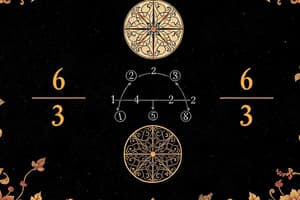Podcast
Questions and Answers
When adding fractions, what do you combine?
When adding fractions, what do you combine?
- Numerators (correct)
- Decimals
- Denominators
- Whole numbers
What is the key requirement for adding fractions with different denominators?
What is the key requirement for adding fractions with different denominators?
- Find a common denominator (correct)
- Multiply the denominators
- Add the denominators
- Change the numerators
Subtracting fractions involves which type of operation?
Subtracting fractions involves which type of operation?
- Division
- Multiplication
- Inverse operation (correct)
- Addition
What should you do if you need to subtract fractions with different denominators?
What should you do if you need to subtract fractions with different denominators?
When subtracting fractions, what happens if one fraction is smaller than the other?
When subtracting fractions, what happens if one fraction is smaller than the other?
In subtracting \( \frac{2}{3} - \frac{1}{3} \), what is the result?
In subtracting \( \frac{2}{3} - \frac{1}{3} \), what is the result?
Flashcards
Adding fractions
Adding fractions
Combine the numerators of fractions.
Adding fractions with different denominators
Adding fractions with different denominators
You must find a common denominator.
Subtracting fractions
Subtracting fractions
It involves an inverse operation, basically doing the opposite.
Subtracting fractions with different denominators
Subtracting fractions with different denominators
Signup and view all the flashcards
Subtracting a larger fraction from a smaller one
Subtracting a larger fraction from a smaller one
Signup and view all the flashcards
2/3 - 1/3 = ?
2/3 - 1/3 = ?
Signup and view all the flashcards
Study Notes
Fractions - Adding and Subtracting
Fractions represent parts of a whole. They can be compared and manipulated using several techniques, including addition and subtraction. These operations involve combining two or more fractions with the same denominator or finding the difference between two fractions, respectively.
Adding Fractions
Addition involves equal division of two equal parts. When you add fractions, you combine the numerators and leave the denominator as it is, provided that they have different denominators. Therefore, when adding fractions, you need to find an equivalent fraction of each fraction with the same denominator. For instance, if we add (\frac{1}{3}) and (\frac{2}{3}), we can find an equivalent fraction of each with the same denominator, resulting in [\frac{1}{3}+\frac{2}{3}=\frac{3}{3}=1]
Subtracting Fractions
Subtraction works similarly to addition but involves the inverse operation. When subtracting fractions, you also need to ensure that they have different denominators. If one fraction is smaller than the other, you can combine them by converting them into equivalent fractions with the same denominator. For example, if we subtract (\frac{1}{3}) from (\frac{2}{3}), we can convert (\frac{2}{3}-\frac{1}{3}=\frac{1}{3}). Alternatively, you could write it as (1-\frac{1}{3}=\frac{2}{3}). In this case, both ways of writing result in the same fraction.
Studying That Suits You
Use AI to generate personalized quizzes and flashcards to suit your learning preferences.




